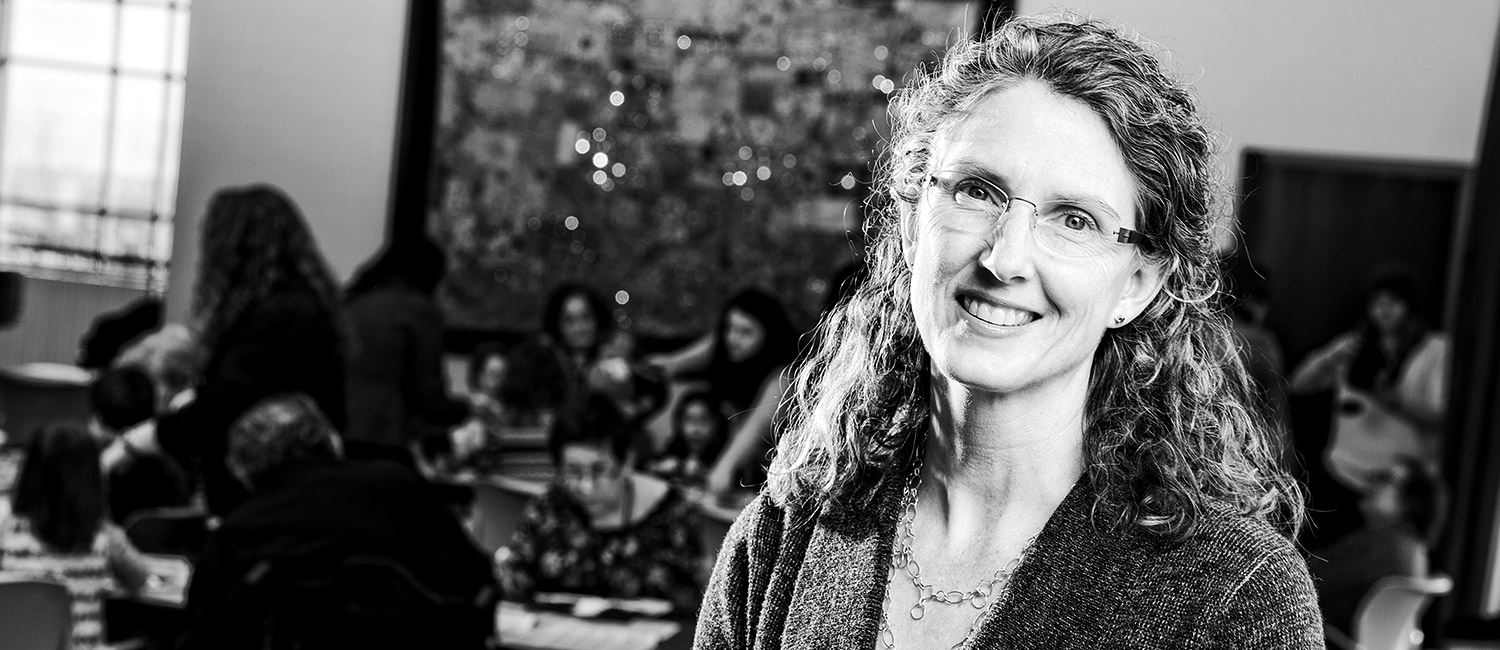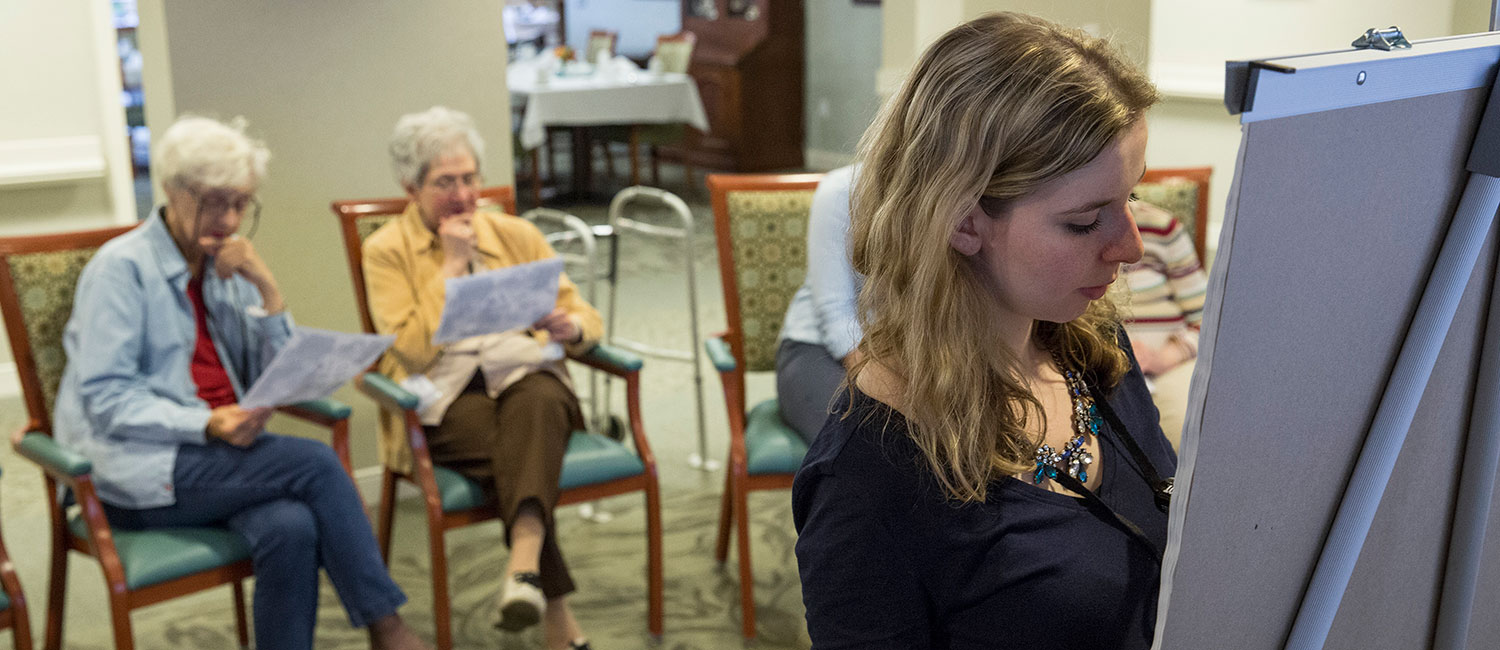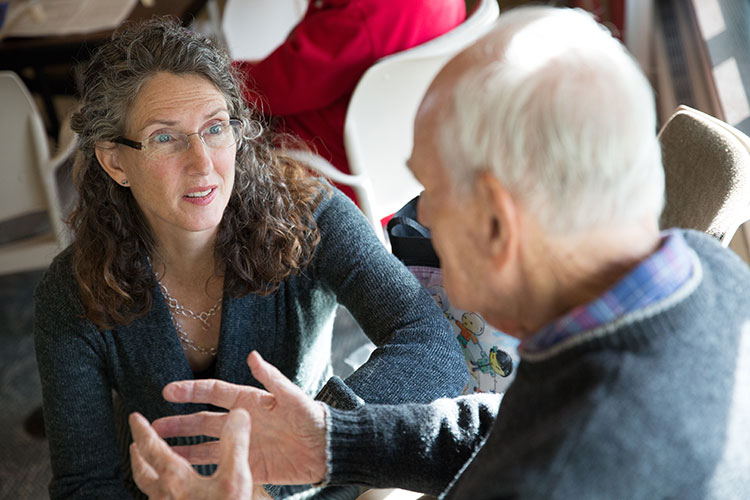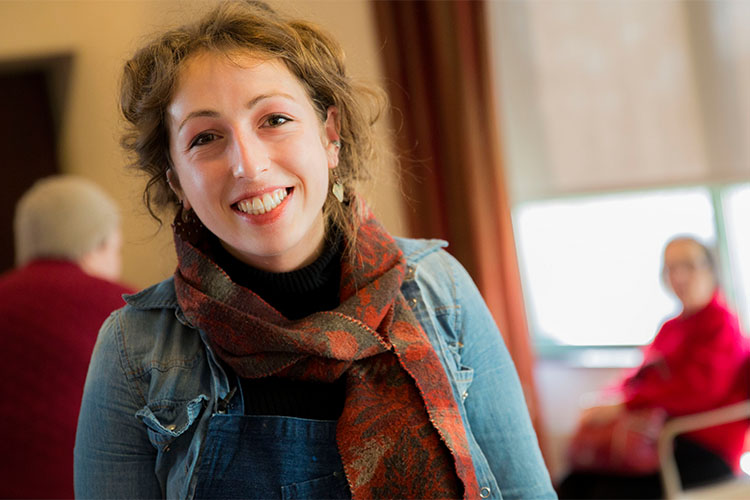
Stories of Age
MacArthur 'genius' fellow Anne Basting reframes how we look at growing old.
Anne Basting has told the story before: How she was volunteering in a nursing home years ago and tried to get a roomful of residents to do memory exercises, to no avail. How, switching gears, she tore a photograph of the Marlboro man out of a magazine and asked the residents to give him a name. How they called him Fred, and how Fred morphed into Fred Astaire, and how they made up a story about Fred Astaire, laughing and singing and giving voice to their imaginations and idled memories.
Basting had just finished her doctoral dissertation on the representation of age in American theater. She returned week after week to the nursing home – “one of the bleakest I’ve ever been in,” she recalls – and ran the same exercise using different pictures. Each time, she got the same enthusiastic responses.
She was on to something.
Now, the Peck School of the Arts theater professor has taken her simple idea to new heights. Using visual prompts to elicit creative imaginings, the 51-year-old has helped people with Alzheimer’s disease and dementia collectively tell stories, write plays and poetry, and stage performances in numerous care centers and arts venues.
She’s documented the results of her creative-expression programs, collecting mounds of data – notes, questionnaires, interviews, videos, photos – that she’s turned into books about the intersection of arts programs and long-term care for people with dementia.
“The social role of a storyteller is almost universally valued.”
Using theater as the vehicle, she wanted to change the way older people thought about their own aging process. “I saw it as a positive way to reframe aging in this country,” Basting says. “The assumption was that people become almost a reduction, to use a cooking metaphor, of their personality.”
Ultimately, her goal was to find more humane and interactive ways to care for people with dementia, with the promise of one day reducing the use of now-abundantly prescribed antipsychotic medications.
In September 2016, word came that Basting had been awarded a MacArthur Fellowship, the very first for a UWM faculty member, the first for a Wisconsinite since Will Allen in 2008, and the first for a Wisconsin academic since 1999. The no-strings-attached $625,000 prize, often called a “genius grant,” marked a nationally prestigious validation of her work.
“Basting has developed an alternative concept of aging,” declared the MacArthur Foundation, “one that focuses on its possibilities as well as its challenges, and views sustained emotional connections as critical to our well-being as we age.”
It was Basting’s early nursing home volunteerism that led to her breakthrough project, TimeSlips. She had chronicled her experiences with the residents and wanted to somehow share them. “They felt like treasure,” she says.
In 1996, while teaching at UW-Oshkosh, she wrote and staged a play, titled “TimeSlips,” based on stories told by people with dementia. Over the next couple of years, she received several grants, including one from the Milwaukee-based Helen Bader Foundation, to replicate the storytelling process at four adult day centers, two in New York and two in the Milwaukee area.
The aim of creative storytelling is to replace the pressure to remember with the freedom to imagine, to inspire improvisational expressions in real time rather than attempt to draw out past memories.
“The social role of a storyteller is almost universally valued, and that is the role that people with dementia take on,” she says. “It is understood that it has value, by the staff, by the family and by themselves.”
Basting formed a nonprofit alliance, The Creative Trust, as a way to foster learning through art. In 2015, with funding from the Bader Foundation, the trust established the Student Artists in Residence program, or SAIR, as a service-learning component to the arts courses Basting taught.
SAIR students are placed at a range of Milwaukee-area community agencies. For the 2016-’17 school year, three are receiving room and board for arts programming at the Eastcastle Place, Chai Point and Luther Manor retirement communities. Two students are getting a stipend for working with Interfaith Older Adult Programs and St. John’s on the Lake. And two other students received UWM research funds for a residency working with the Shorewood School District on diversity issues.
In addition, through UWM’s Center for Community-Based Learning, Leadership and Research, about 25 trained students lead TimeSlips storytelling workshops each semester at local care communities. TimeSlips, now a registered nonprofit, offers manuals and online training through its website. Joan Williamson, TimeSlips coordinator and master trainer, says it has trained more than 2,000 facilitators in 41 states and 12 countries.
TimeSlips benefits students, residents and a retirement home’s culture, says Angie Crimmings, LifeStreams coordinator and student supervisor at St. John’s on the Lake. She says the goal is to have every staff member and volunteer trained in TimeSlips.
“By doing this, we are giving the staff the tools to engage residents, to spark conversations and to develop relationships,” Crimmings says. “So the need for medications related to behavior is reduced. Overall, this will provide better quality care.”
On a Thursday afternoon, seven St. John’s residents sit in a semicircle in a small but warm room, all facing a blank flipchart. Each has a cognitive disability – Alzheimer’s disease, dementia – and some, but not all, seem to remember they’ve been here before.
Standing at the flipchart are three UWM student volunteers – Yvette Macias, a nursing student; Julia Stowe, a bioscience major; and Diego Dominguez-Ramirez, a physics major. They will lead the seniors through a session of creative storytelling.
The students hand out copies of a photograph showing an outdoor table filled with baked goods. In the photo, one woman is slicing a piece of pie, while another woman is placing food onto a plate. Behind the women, a group of children and adults mill about.
“So,” asks Julia, “what do you see in this picture?”
“It looks like there’s a huge number of people waiting to come and look, and there’s lot of bake sale stuff,” says one woman, the most outgoing of the bunch. Yvette writes her remarks on the flipchart.
“Must be a very formal neighborhood,” says another woman, smiling slyly.
“I think the greatest thing that I learned was to use my imagination and let my imagination fly.”
“Cheese and crackers and cake. And that looks like a ham,” adds the woman, pointing to the photo in her lap. “And this could be a pie, upside down. There’s a variety of homemade goods.”
“They look like Quakers,” observes another woman, and the comments sail through the room.
“They bought a ticket for a party for lunch.”
“People with hats on, and I don’t understand that.”
“It looks like a typical fundraiser for a school or a church.”
“It looks like they’re waiting in line for their turn,” says another woman, the shyest of the group.
Sitting in a wheelchair, one resident is visibly pleased by the activity. “Isn’t that something.”
The students pause and gather the group’s attention. “OK,” Julia says, “we’re gonna give it a read and see what we have so far.” As she reads, the residents’ observations begin to form a story:
It looks like a bake sale. There are people with hats on, and I don’t understand that. They look like Quakers to me. It must be a formal neighborhood. They bought a ticket for a party for lunch. They’ve got cheese, crackers, cake, ham and maybe an upside-down pie. There’s a variety of homemade goods. They look like they’re waiting in line for their turn to come. Isn’t that something…
The brainstorming is repeated, twice, and as the story builds, remarks are proffered. The residents become animated, excited to be involved in this interactive process of story-making.
After the session, the students will transcribe the comments, share them with the residents, then submit the narratives to a St. John’s supervisor, who will distribute the stories more widely, in books, for example, or newsletters. St. John’s holds a celebration every spring to showcase the TimeSlips stories and other creative-engagement projects.
“The possibilities are limitless,” says Williamson, the TimeSlips coordinator. She shares how a couple of years ago, St. John’s residents were asked to create art from their stories. An exhibit was staged and the public was invited, along with families, staff and volunteers. “The residents were still talking about it nearly a year later.”
Several media outlets and research publications have focused on the TimeSlips program – from the journal The Gerontologist to NBC’s “Today” show. In December 2016, an Associated Press report augmented its coverage with video from a TimeSlips session in Japan. The MacArthur Foundation grant brought a new wave of interest, but Basting’s work was already well-known.
In the first study to use qualitative methods to gauge how memory-care residents and staff may benefit, Penn State College of Medicine researchers published a 2014 report in the American Journal of Alzheimer’s Disease & Other Dementias.
Comparing two dementia care units in a Pennsylvania retirement community, researchers observed 10 participants in two one-hour TimeSlips sessions per week for six weeks. There was also a control group of 10 residents who received standard-of-care programming. Participating residents and staff members were interviewed.
The study found no significant statistical differences between the groups in mood, symptoms or prescribed use of psychotropic drugs. Yet themes emerged from the data that indicated benefits for residents, staff and the nursing home community in general: increased creativity, improved quality of life, positively altered behavior and involvement in meaningful activities.
“Staff members frequently noted a sense of anticipation, liveliness, laughter, and fun in the residents,” the report notes of the TimeSlips group. “As one staffer said, ‘It surprised me how awake and involved people became.’”
The study recommended larger trials of longer duration to confirm whether programs such as TimeSlips “can, over time, improve relationships between residents and care staff, reduce the usage of antipsychotic drugs that carry significant risks, improve quality of life, and lower the cost of long-term care.”
Basting is convinced the TimeSlips method could indeed act as a substitute for certain meds – antidepressants, for example. She’s not convinced a longitudinal study will prove that, or is even necessary.
“The expectation of that kind of research for these types of creative interventions is mislaid,” she says. “When the pressure is for large-scale, double-blind, randomized-control test studies – which are perfect for pharmaceuticals but not perfect for nuanced, complicated relationship-building – then people want to know the dosage, how many times a week do we have to do a creative storytelling session. And I’m like, ‘You’re just missing the point.’
“What we are doing is reducing the toxicity of the care environment,” she says. “Overall, we are creating an enriched, supportive care environment, so you don’t have expressions of psychological or physical pain that manifest themselves in chronic problem behavior. The treatment for that is antipsychotics – to dull people into submission.”

Basting’s TimeSlips method diverged into several other projects on the heels of its eponymous 1996 play. Arriving at UWM in 2003 as an instructor and founder of the university’s Center for Age and Community, she wrote a resource guide, “The Arts and Dementia Care,” and a play based loosely on her relationship with her mother, titled “Unraveling Alice.” Her 2009 book, “Forget Memory: Creating Better Lives for People with Dementia,” was based on her TimeSlips practices and received critical acclaim.
In one of her most ambitious projects, Basting and her students collaborated with the nationally renowned Sojourn Theatre, as well as residents and staff of Luther Manor, to create a multimedia performance, “Finding Penelope.” Written by Basting, set in several of the nursing home’s public spaces, and constructed from storytelling exercises by the residents, the play was performed by professional actors as well as Luther Manor staff and residents.
“Finding Penelope” is a retelling of Homer’s “Odyssey” from the perspective of Penelope, queen of Ithaca and steadfast wife of Odysseus. When the philandering Odysseus returns home after 20 years, Penelope cannot be found. Odysseus finally discovers her in a long-term care center. She doesn’t recognize him at first. But Odysseus and Penelope, who is represented on stage by a chorus of Luther Manor residents, eventually reunite.
A two-year project that was staged in March 2011, the performance was made into a documentary, produced by filmmaker Brad Lichtenstein, Basting’s husband. A book, “The Penelope Project,” followed, analyzing the process and evaluating the project’s impact using collected data – interviews, blog entries, emails, focus group transcripts, surveys, photographs, video and film recordings, and other artifacts.
“I think the greatest thing that I learned,” one resident said, “was to use my imagination and let my imagination fly.”
TimeSlips continues to replicate its storytelling model. It recently received a state contract to train facilitators in the creative community method of care in 50 Wisconsin nursing homes.
“We’re going to apply each year and do 50 each year until we run out of nursing homes,” Basting says. “We’re transforming places – ones locked in a medical model – into cultural centers. They’re becoming places of meaning-making.”
With her MacArthur grant as a financial buffer, she’ll set aside money for her two sons’ college education and shore up her retirement fund.
And perhaps slow down, contemplate an early retirement?
“No,” she says, decidedly. “I am going to buy a banjo, though.”
She explains how she’s hatching a project to incorporate Appalachian music and storytelling techniques into 60 care communities in eastern Kentucky and Tennessee.
“I’m writing grants right now for that,” she says. “So it’s a perfect time to learn how to play the banjo.”

